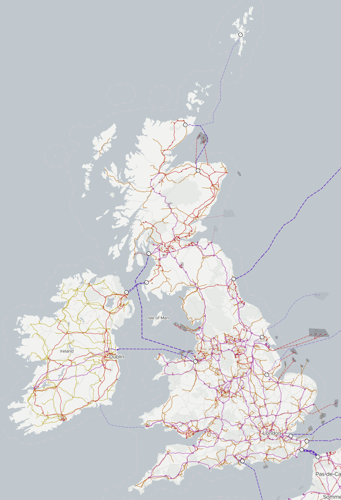The UK’s Electricity Supply Network In A Nutshell
The amount of electricity needed to power the UK’s 5.5-million businesses is immense. So understandably, the supply network required to deliver that power is absolutely massive too.
And, if you’re not careful, expensive too. Which is why businesses should compare and switch energy suppliers to keep their overheads low.
That being said, all that electricity gets to businesses in the UK thanks to the National Grid, which owns the national electricity transmission system in England and Wales. The National Grid looks after:
- around 4,500-miles of overhead line,
- over 900-miles of underground cable,
- and over 300 substations.
And that’s not counting the 117,949-miles of high voltage electricity cables operated by UK Power Networks that power 8.4-million properties across London, the South East, and East of England.
Meanwhile north of the border, Scotland is laced with 71,000-miles of electricity cable and 98,000 electricity transformers.
Regardless of where a company is based, British businesses can keep their electricity and gas bills low and secure energy quotes in under 30 seconds from a range of trusted UK energy suppliers here at British Business Energy.
We’ve already completed over 350,000 business energy switches all over the UK; maybe it’s time you joined them – compare electricity suppliers today.
Where are the UK’s longest and tallest powerlines?
‘Long’ doesn’t even start to accurately describe it, but the UK’s longest powerline is the Aust Severn Powerline Crossing, which stretches for 1,700-metres (5,310 ft) between two towers 148-metres (488 ft) high either side of the River Severn.
The UK’s tallest electricity pylons can be found beside the River Thames at the 400 kV Thames Crossing in West Thurrock, which top out at 190-metres (630-ft) high.
Where does the UK’s electricity come from?
The energy that powers these British businesses comes from a variety of sources, some UK-based, some overseas, hence the disruption and uncertainty in the energy market following Russia’s invasion of Ukraine in 2022.
That energy generated from other power sources, such as coal, natural gas, nuclear power and renewables like wind power, solar power, bioenergy (organic matter burned as a fuel) and hydroelectric, including tidal energy.
A map of Britain’s power supply network
So that’s a little about the UK’s power supply network, but what does it look like?
Created by OpenInfra Map, the image below outlines an overview of Britain’s power lines.

Why pay more for the same energy?
Keep your business energy bills low
Find your latest energy deal in less than 30 seconds
Find the Latest Deals
Secure business energy quotes in under 30 seconds from a range of trusted UK energy suppliers.